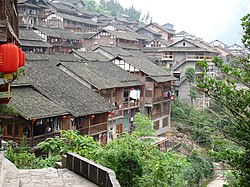Top Qs
Timeline
Chat
Perspective
Youyang Tujia and Miao Autonomous County
Autonomous County in Chongqing, China From Wikipedia, the free encyclopedia
Remove ads
Youyang Tujia and Miao Autonomous County, or Youyang County for short (simplified Chinese: 酉阳土家族苗族自治县; traditional Chinese: 酉陽土家族苗族自治縣; pinyin: YǒuYáng Tǔjiāzú Miáozú Zìzhìxiàn) is located in southeastern Chongqing Municipality, southwest China, bordering the provinces of Hunan to the east and Guizhou to the southwest.
The county spans an area of 5,173 km2 (1,997 sq mi), and has a population of approximately 854,400 people as of 2018.[2][3]
Remove ads
History
Youyang was known as Youzhou in ancient times.[citation needed]
Geography
Summarize
Perspective
Youyang Tujia Miao Autonomous County is located east of Wu River and west of Youshui River.[2] It is the largest county-level division of Chongqing, having an area of 5,173 km2 (1,997 sq mi).[2]
The county contains about 1.5939 million mu (1,062.6 km2 or 410.3 sq mi) of arable land, 4.46 million mu (2,973.3 km2 or 1,148.0 sq mi) of forested land, and 2.92 million mu (1,946.6 km2 or 751.6 sq mi) of grassland.[citation needed]
The Wuling Mountains run through the county, and the county's highest point reaches 1,895 metres (6,217 ft) above sea level.[2]
Climate
Remove ads
Administrative divisions
Summarize
Perspective
Youyang Tujia and Miao Autonomous County is divided into 2 subdistricts, 19 towns, and 18 townships.[7] These are then divided into 8 residential communities, and 270 administrative villages.[2]
|
|
Demographics
As of 2018, the county has a population of approximately 854,400 people.[3] Of this, 275,000 live in urban areas, and 579,400 live in rural areas.[3]
Vital statistics
In 2018, the county registered a birth rate of 10.89 per thousand, a death rate of 5.74 per thousand, giving it a rate of natural increase of 5.15 per thousand.[3]
Ethnic groups
Youyang Tujia and Miao Autonomous County is home to 16 ethnic minorities,[citation needed] including the Tujia and Miao people, for which the county is named.[3]
Remove ads
Culture
The county is nicknamed the "Cradle of Tujia people" for its rich Tujia culture.[citation needed]
It is the home of the Baishou Dance, a symbolic tradition of Tujia people.[8] It is a traditional dance which involves waving hands to convey stories of human origins, myths and legends, ethnic migration, ancient wars, hunting and fishing, forestry, labor, food, and other aspects of social life.[8] The dance was added to the second batch of the China National Intangible Cultural Heritage List on June 7, 2008.[8]
The county is also home to a number of traditional folk songs, which perhaps date back to the Southern Song dynasty.[8] The folk songs are popular at festivals, weddings, funerals, and other activities.[8]
Remove ads
Economy
The county has a labor force 40-50% cheaper than that of coastal areas.[citation needed] It is one of the counties with the most water resources in China, and has more than 20 kinds of mineral resources.[citation needed] Youyang is also a "Sanmu" (Chinese: 三木) production base, as it grows three major plants used in Chinese medicine: Eucommia ulmoides (Chinese: 杜仲), Magnolia officinalis (Chinese: 厚朴), and Phellodendron amurense (Chinese: 黄柏).[2] The country as a whole grows about 1,200 kinds of Chinese herbal medicine materials, and is home to large amounts of Artemisia annua.[2]
Remove ads
Tourism
Summarize
Perspective
Taohuayuan
Taohuayuan (Chinese: 桃花源) is a 5A Tourist Attraction, the highest rank of designated attractions in China.[2] Located in the northern corner of the county, Taohuayuan is a place at first described in The Peach Blossom Spring written by Tao Yuanming, a famous writer of the Eastern Jin dynasty (317–420).[citation needed] It is notable that there are more than one Taohuayuan spots in China, and the one in Youyang is a nationwide recognised Taohuayuan.[citation needed]
Gongtan Ancient Town
Gongtan Ancient Town (Chinese: 龚滩古镇) is located at the intersection of Wu River and Apeng River, and it is a 4A Tourist Attraction.[citation needed] It has a history of more than 1,700 years.[citation needed] More than 200 courtyards and stilted buildings from the Ming Dynasty and Qing Dynasty are preserved in Gongtan.[citation needed]
Wu River Gallery
Wu River Gallery is the 60 km (37 mi) long, naturally formed river bank of Wu River in Chongqing Youyang, and it is a 4A Tourist Attraction.[citation needed] It is famous for the strangely shaped mountains along the gallery.[citation needed]
Longtan Ancient Town
Longtan Ancient Town (Chinese: 龙潭古镇) is an ancient town with ancient wood architecture.[citation needed]
Remove ads
Notable people
- Zhao Shiyan, communist revolutionary
References
External links
Wikiwand - on
Seamless Wikipedia browsing. On steroids.
Remove ads



